class: center, middle, inverse, title-slide # Week 12: Terrorism ## The rational terrorist ### Danilo Freire ### 26 November 2019 --- <style> .remark-slide-number { position: inherit; } .remark-slide-number .progress-bar-container { position: absolute; bottom: 0; height: 6px; display: block; left: 0; right: 0; } .remark-slide-number .progress-bar { height: 100%; background-color: #EB811B; } .orange { color: #EB811B; } </style> # Two week ago, we saw that .font150[ * There has been many waves of terrorist activities, from the French Revolution to Radical Islamism today * Jacobins, Narodnaya Volnya, Irish nationalists, Young Bosnia, anti-colonial movements, left-wing terrorist groups, Al Qaeda, etc * Terrorism has been used both by governments and by non-state actors alike * Definition: _use of violence, or threats of violence, to intimidate others, directly or indirectly, to achieve political goals_ ] --- # Two week ago, we saw that .font140[ * We also discussed some situations in which terrorism might be morally acceptable - Groups facing oppression, extreme violations of human rights * Moral issues: - Disrespect for war conventions, targeting innocent civilians, intent is difficult to justify * Different definitions of terrorism have significant impact over our analyses * It is a rational strategy, but it doesn't always work ] --- # Early Warning Project updates .center[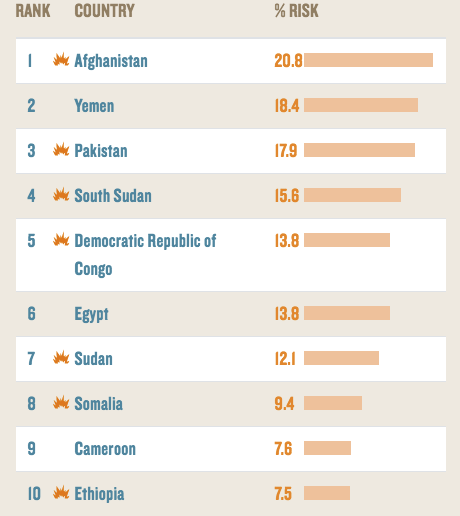] .center[<https://earlywarningproject.ushmm.org/ranking-of-all-countries>] --- # Early Warning Project updates .center[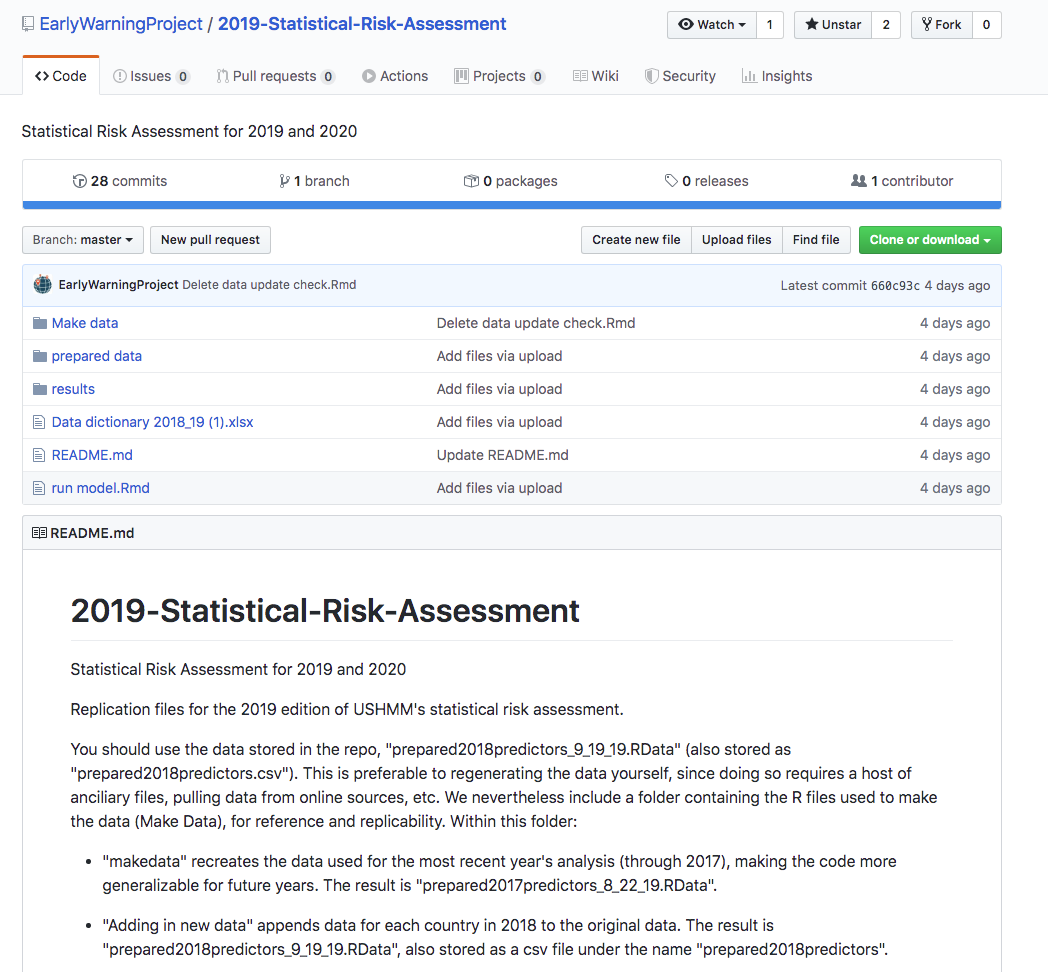] .center[<https://github.com/EarlyWarningProject/2019-Statistical-Risk-Assessment>] --- class: inverse, center, middle # The rational terrorist <html><div style='float:left'></div><hr color='#EB811B' size=1px width=800px></html> --- # Andrew Kydd and Barbara Walter .center[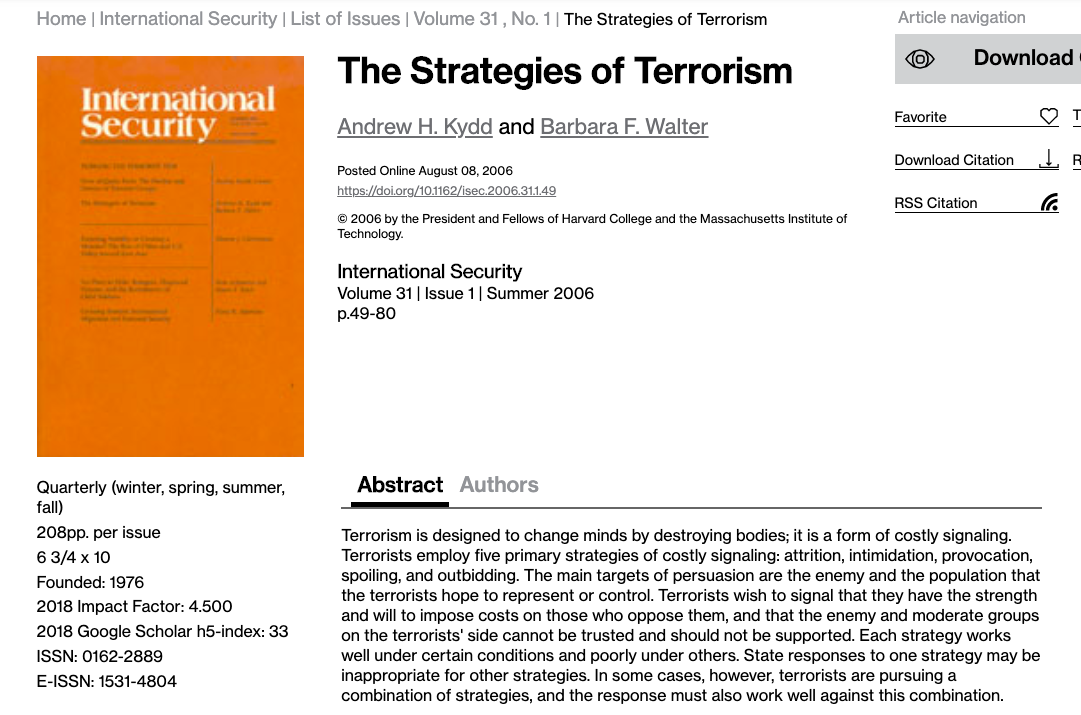] --- # The strategies of terrorism .font150[ * "Terrorism often works." * Between 1980 and 2003, half of all suicide terrorism campaigns resulted in concessions by the government * "Hijacking planes, blowing up buses, and kidnapping individuals [...] can be surprisingly effective" * For counter-terrorism strategies to work it is important to understand what those groups want and whether/how they achieve their goals ] --- # The strategies of terrorism .font150[ * The authors seek to answer four questions: - What types of goals do terrorists seek to achieve? - What strategies do they pursue to achieve these goals? - Why do these strategies work in some cases but not in others? - What are the targeted governments’ best responses to prevent terrorism and protect their countries from future attacks? * Main explanatory variable: _costly signalling_ ] --- # The goals of terrorism .font150[ * The press usually portraits terrorist groups as crazy extremists * This is particularly true for _suicide terrorists_ * Individuals have different motivations from their groups - Suicide bombers may seek financial benefits for their family or a pleasant afterlife - But the leaders have rational political goals ] --- # The goals of terrorism .font150[ * The authors argues that terrorist groups have five goals: - Regime change (Sendero Luminoso, Hezbollah, Taliban) - Territorial change (Tamil Tigers, Lashkar-e Tayyiba in Kashmir) - Policy change (Al-Qaeda, Hamas) - Social control (KKK, Fascist regimes) - Status quo maintenance (LatAm paramilitaries, IRA) * Regime change is the most common, followed by territorial change * Many organisations have multiples goals at the same time ] --- # The strategies of terrorist violence .font150[ * So how do terrorist groups try to achieve their goals? * The authors argue that _uncertainty_ and _costly signalling_ provide a good explanation] -- .font150[ * **Uncertainty**: groups don't know what their enemies can do or how committed they are to a given policy * This setting of incomplete information leads to miscalculations and under- or over-estimation of the enemy's capabilities ] --- # The strategies of terrorist violence .font150[ * How to reduce uncertainty? _Provide reliable communication_ * However, simple verbal statements are not credible: people lie and bluff * *How to convey reliable information?* ] -- .font150[ * **Make that information costly to send**] --- class: inverse, center, middle # Brief digression on costly signalling <html><div style='float:left'></div><hr color='#EB811B' size=1px width=800px></html> --- # Why do peacocks have such long tails? .center[] --- # Bird of paradise .center[] --- # Gazelles stotting .center[] --- # Luxury goods .center[] --- # Luxury goods .center[] --- # Facial tattoos .center[] --- # ... back to terrorism .font150[ * _Costly signalling_ indicates resolve and commitment * Violence, mainly _suicidal violence_, is an extreme form of costly signalling * How do terrorists use violence? According to five strategies, the authors argue ] --- # Five strategies .center[] --- # Attrition .font140[ * Attrition campaign: to persuade the enemy that the group is strong * The greater the costs terrorists inflict today, the stronger the signal that they will inflict _even greater_ costs in the future * Anti-colonial terrorism, Hamas, Hezbollah, Al Qaeda * Democracies are particularly _unlikely_ to retaliate and faces higher audience costs, thus they are the favourite target of attrition strategies ] --- # Responses to attrition .font150[ * Governments can make some concessions in non-crucial areas (fiscal autonomy, etc) * Retaliation is a better strategy if the terrorists threaten core competences of the state * Harden likely targets (additional security checkpoints, etc) * Deny access to most destructive weapons (biological, nuclear, etc) * Minimise psychological damage (keep calm and carry on) ] --- # Intimidation .font150[ * Similar to deterrence: preventing undesired social behaviour with threats of, and actual, violence * Targeted at the population terrorists are trying to control * Left-wing groups, KKK, state terrorism * Weak states facilitate intimidation strategies ] --- # Responses to intimidation .font150[ * Territorial claims: state should retake control over the territory * "Clear, hold, and build": invest in state capacity * Social control: better law enforcement * Bypass local leaders ] --- # Provocation .font150[ * Used in pursuit of regime change and territorial gains * Designed to persuade the domestic audience that the target of attacks is evil * The goal is to shift citizen support away from the incumbent regime * ETA: Spanish government reacted very strongly, so the population was shocked by the violence * Democracies, again, are likely targets of provocation ] --- # Reactions to provocation .font150[ * "Seek and destroy", but try to isolate civilians * Gathering information about the group * Targeted killings ] --- # Spoiling .font150[ * Terrorists use violence to force the government to negotiate or increase their bargaining power * Often used when two enemies are close to reaching an agreement - Israel and PLO, Hamas spoiled the Camp David Agreements * More likely to happen when moderates of a given groups are unlikely to hold extremists, or merely when the other party thinks that this is the case ] --- # Responses to spoiling .font150[ * If mutual trust is high, negotiations should continue regardless of the terrorist attacks * Since trust is often scarce, trust-building initiatives might work * Power-sharing agreements, post-treaty reconciliation commissions, etc * Effective protection of minority rights ] --- # Outbidding .font150[ * "[...] when two or more domestic parties are competing for leadership of their side, and the general population is uncertain about which of the groups best represents their interests" - Hamas versus Fatah * Moderates can actually _prefer_ the radicals to gain more prominence close to negotiations with the enemy: lower margin for bargain * Citizens might believe their representatives will "sell out", so they might prefer the zealots to step in * As expected, outbidding is more likely to happen when many groups are competing for power ] --- # Responses to outbidding .font150[ * Encourage competing groups to form a coalition * If not possible, grant them concessions * Favour one of the groups? ] --- # Conclusion .font150[ * States and terrorists groups don't know the capabilities of their respective enemies * Terrorists use violence to signal that they are committed to their causes * (States can do the same too!) * Five strategies: - Attrition, Intimidation, Provocation, Spoiling, and Outbidding ] --- class: inverse, center, middle # Questions? <html><div style='float:left'></div><hr color='#EB811B' size=1px width=800px></html> --- # Robert Pape .center[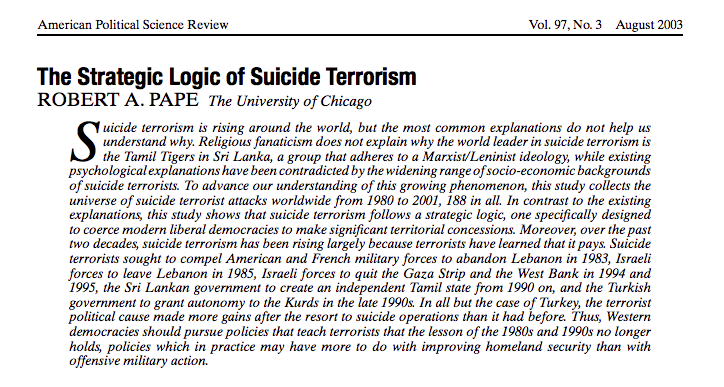] --- # Introduction .font140[ * Terrorist groups increasingly rely on suicide attacks * Before the 1980s, suicide attacks were rare * First wave explanations: - Religious fanaticism, psychological dispositions * The world's leaders in suicide attacks are the Tamil Tigers (Sri Lanka) * Large variation in terrorist characteristics (gender, education, age, etc) * Pape argues that terrorism follows a _strategic logic_ ] --- # How can suicide be rational? .font150[ * Even if the person who commits a suicide attack is not rational, _the leaders probably are_ * Thomas Schelling: "rationality of irrationality" (The Strategy of Conflict) * Niccolò Machiavelli: "it is a very wise thing to simulate madness" (Discourses on Livy, 3:2) * Suicide terrorism is analogous to international coercion (madman theory) ] --- # Defining suicide terrorism .font140[ * Suicide terrorism is an attack in which the death of the perpetrator is required for the attack to succeed * Usually, the goal is to the highest number of people as possible * This forces the government to consider the demands of the terrorist group * It is a coercive strategy: - While the military coerces people because it is strong, terrorists coerce people because they are weak * However, this coercion might alienate potential supporters, too ] --- # Defining suicide terrorism .font150[ * Suicide attacks increase the coercive effect of terrorism * They are generally much more destructive (suicide vests, hijacking planes); * Very strong costly signal: if terrorists are willing to die for the cause, what _can't_ they do? * Better able to communicate commitment and increasing levels of violence in the future ] --- # The record of terrorism .center[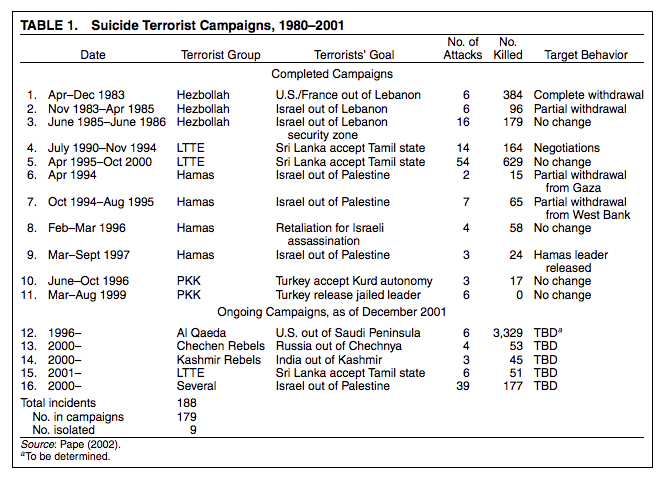] --- # The record of terrorism .font150[ * _Timing_: From 188 attacks, 179 (95%) were part of a campaign * End of the campaigns determined by the leaders when they believe some of their demands have been achieved * _Nationalist goals_: since costs of suicide attacks are high, groups resort to them only when stakes are very high, too * Every campaign from 1980 to 2001 has been directed to take "foreign invaders out of the homeland" ] --- # The record of terrorism .center[] --- # The record of terrorism .font150[ * _Democracies as targets_: all groups in the sample attacked democratic regimes * **Why?** ] -- .font150[ * Democracies are less likely to use force domestically * Democracies make more concessions to opposition groups * Democracies have free press and uncensored social media, which publicise the attacks ] --- # Terrorists' assessment of suicide terrorism .font150[ * Suicide attacks have become more common because they often work * In the case of Hezbollah, Hamas, and the Tamil Tigers, they were able to force the state to negotiate in about 50% of the cases * But this also implies that the attacks often failed, too * The most successful group which uses suicide terrorism is Hamas ] --- # The limits of suicide terrorism .font150[ * In the 1980s, terrorist leaders thought that moderate punished led to moderate concessions; but do harsh punishments lead to greater concessions? * _Apparently not_ * Suicide terrorism campaigns are only modestly more successful than their alternatives * Suicide terrorism is unlikely to make states change policies that are crucial to their survival ] --- # Policy recommendations .font150[ * Concessions might be useful in the beginning, but this strategy has clear limitations * Pape proposes demographic separation to deal with terrorism. What do you think? ] --- # Conclusion .font150[ * Suicide attacks follow a strategic logic and are clustered over time and across space * They are more destructive and show stronger resolve * Democracies are often targeted by terrorist groups * Suicide terrorism often works, but can't change important issues in the enemy state * Hamas, the Tamil Tigers, and Al Qaeda are the most significant examples of suicide terrorists ] --- # John Horgan .center[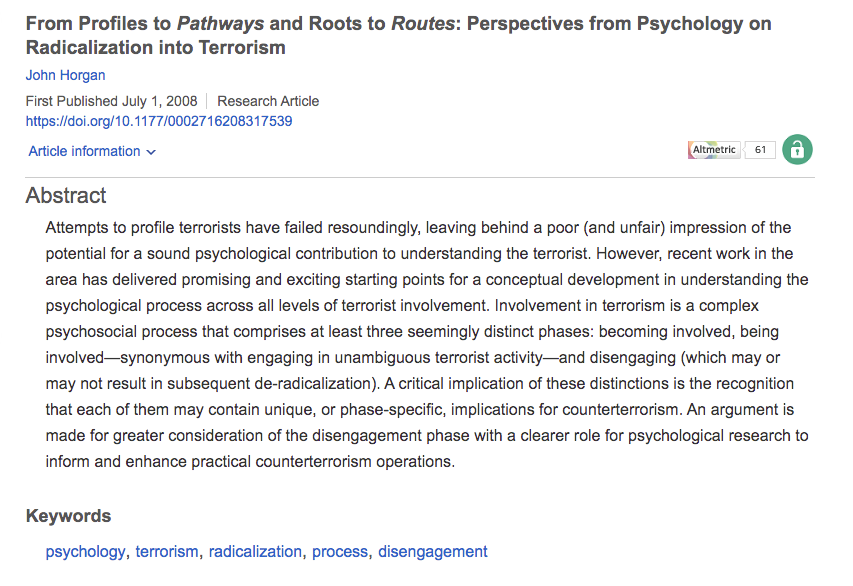] --- # Introduction .font150[ * Why do people join terrorist groups? * Very few people engage in terrorism, so all generalisations are made from a small sample * Another issue is that of profiling: treating terrorists as pathological cases * For instance, 2 million Muslims live in the UK, many sharing similar social, political, economic, and religious conditions - Why do only very few radicalise? ] --- # Openness to socialisation into terrorism .font150[ * While avoiding profiling, the author lists some factors that increase the risk of radicalisation * Feelings of anger, alienation, and disenfranchisement * The perception that conventional political activity does not work * Identification with victims, either real or in more abstract terms * Beliefs that violence against the state or against fellow citizens is not immoral ] --- # Openness to socialisation into terrorism .font150[ * Sense of reward, either in this or in the afterlife * Kinship and social ties, sense of belonging * **Question**: which one do you think is the most important? Is there any factor that he missed? ] --- # Terrorist pathways .font150[ * Terrorist organisations have a myriad of positions, so many members don't have the same role for a long time - People involved in violent attacks participate in political negotiations, etc * Qualitative interviews highlight some similarities in the pathways: - Role models (the Prophet, Wahabi leaders, Che, Fidel) - Families involved in the community - Sense of respect for terrorists - Material incentives ] --- # Implications for counter-terrorism .font150[ * Since it hard to fix the "push factors" (general conditions), states should focus on the "pull factors" * Expose activities of the leaders that other members find immoral * Invest in counter-propaganda showing the impact of terrorism on the victims * Use the most credible sources at their disposal ] --- # Conclusion .font150[ * Since there number of terrorists is very small, current conclusions are conditional on particular characteristics of each case * Some factors do appear to be correlated with engagement in terrorist activities: - emotional vulnerability, dissatisfaction with politics, identification with the victims, belief that violence is morally justified, sense of belonging, social ties * Terrorists occupy different positions in their careers * Counter-propaganda can be used to dissuade terrorists ] --- # Diego Gambetta and Steffen Hertog .center[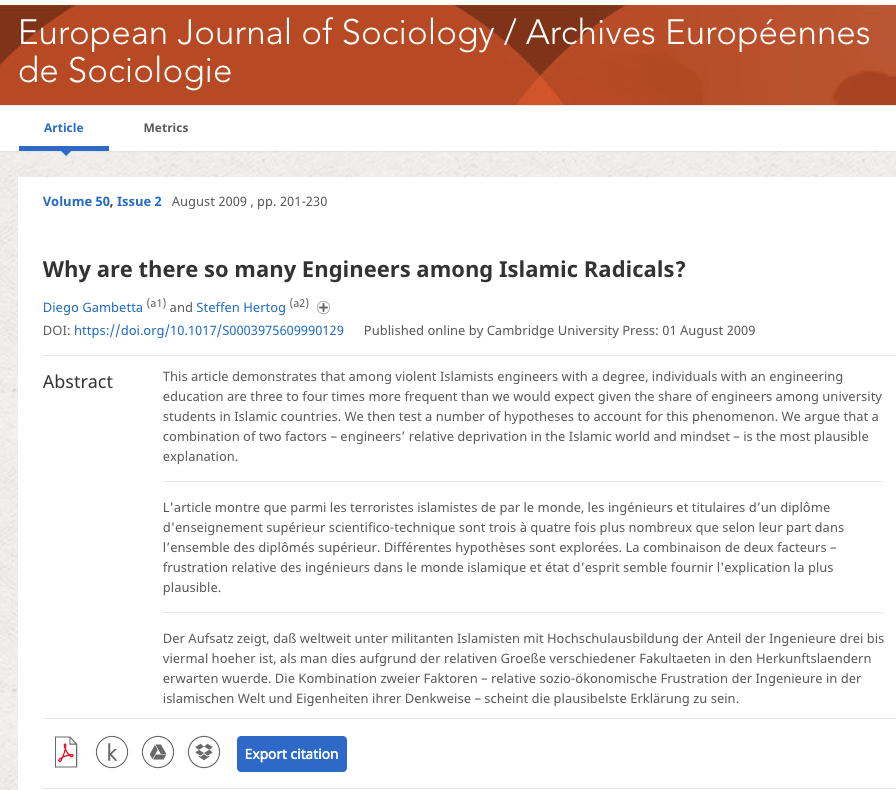] --- # Introduction .font150[ * A large number of Islamic terrorists have engineering degrees * While there is indeed a correlation between years of education and militancy in left-wing and Islamist groups, it is unclear why engineers comprise such a big share of radical Muslims * Although the authors also agree that terrorist profiles vary substantially, some particular cognitive and personality traits might be similar * Education choices might be a proxy for some of them ] --- # Islamic extremists in Muslin countries .center[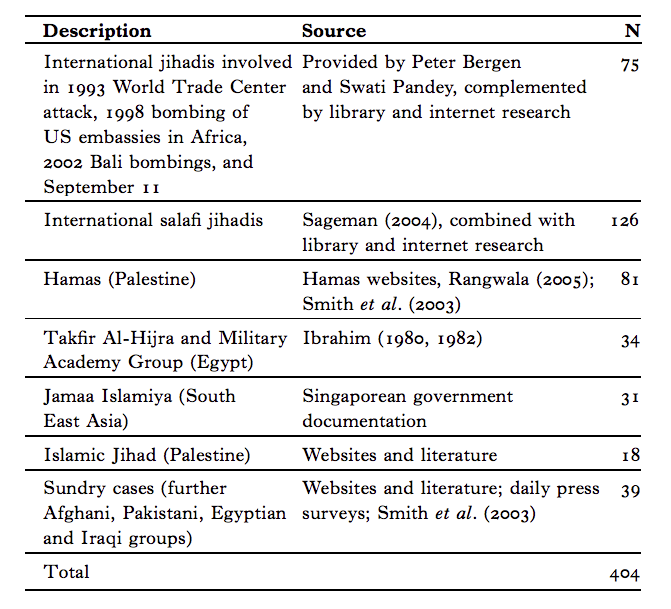] --- # Islamic extremists in Muslim countries .font150[ * Sample of 404 terrorists * They found educational information for 284 individuals * 196 (69%) had higher education, whereas university enrolment rates in the Arab world was around 12% * 44% of them were engineers, in contrast with 2-3% in the general population * Saudi Arabia is an exception ] --- # Islamic extremists in Muslim countries .center[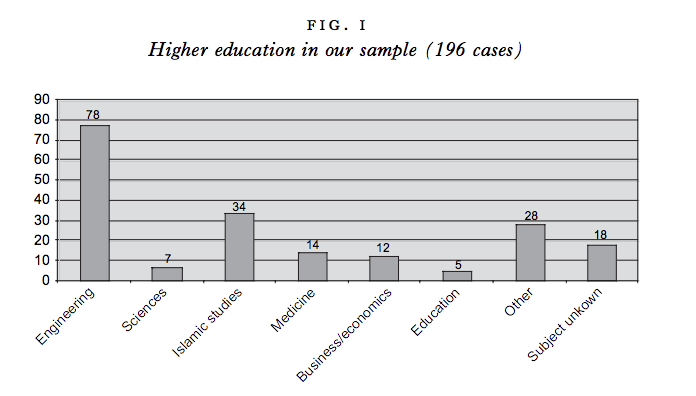] --- # Islamic extremists in Western countries .font150[ * 265 terrorists, the authors found educational information for 54 cases. 21 had university degrees] .center[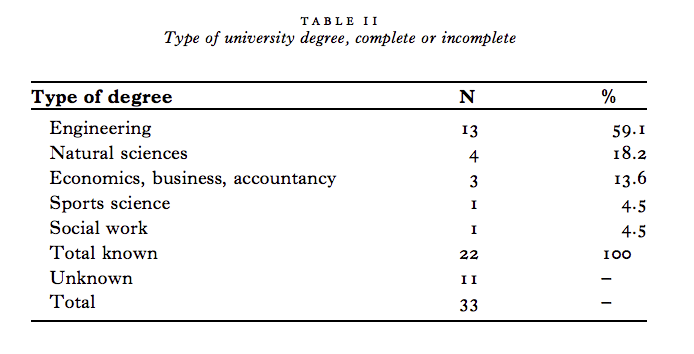] --- # Non-violent Islamists .center[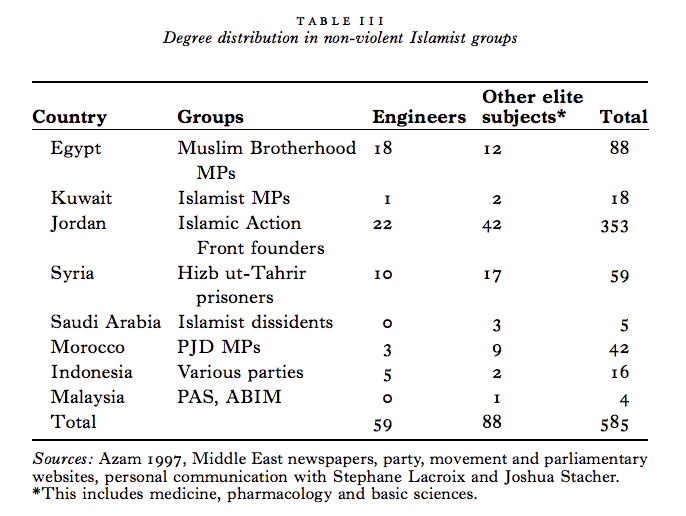] --- # Non-Islamic extremists .font150[ * What if engineers are more likely to be extremists _in general_? * Not the case: the RAF, the Japanese Red Army, the Italian Red Brigades, and Latin American urban guerrilla groups included almost no engineers * Among right-wing extremists, who generally had much lower levels of education, engineers if not over-represented are at least clearly present * Right-wing engineers do not stand out as strikingly as Islamic radical engineers ] --- # Hypotheses .font140[ * Network diffusion - Social ties are crucial for the success of illegal networks - If the first movers were engineers, they tend to continue recruiting engineers to join the groups - They find out this is not the case * Technical skills - No evidence this was the major recruitment criterion - No need for high technical expertise * Both are unconvincing ] --- # The engineering "mindset" .font140[ * Do engineers have more radical views? * US data: about 58% of engineers declare that they are conservative, more than any other group * Science (1972): "No other variable differentiates politically among American academics as effectively as their professional field" * Engineers are also the most religious group of academics: 66% * They are also more likely to be both conservative and religious in other Western countries ] --- # Mechanisms .font150[ * The authors then explore some _possible_ mechanisms * Dislike for ambiguity and an appreciation for "the most efficient way" to solve problems * This is probably due to self-selection, not education * Also, engineering has high prestige in Muslim countries, so individuals might be more ambitious than average, too * Technocratic idea of development, but lack of opportunities ] --- # Mechanisms and conclusion .font140[ * Result: _frustration_ and _relative deprivation_ * An explosive mix: - A conservative and religious group; - Who sees the world as an ordered cosmos, where everyone has their own place; - With largely frustrated professional and personal development expectations; - Without the possibility to express their concerns in authoritarian regimes - _Radicalisation_ * **Question**: does that seem convincing to you? ] --- class: inverse, center, middle # See you next week! <html><div style='float:left'></div><hr color='#EB811B' size=1px width=800px></html>